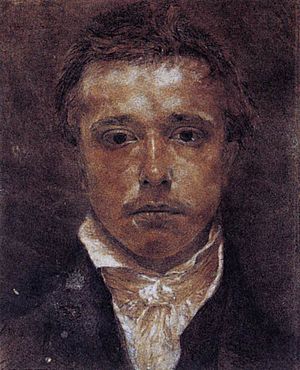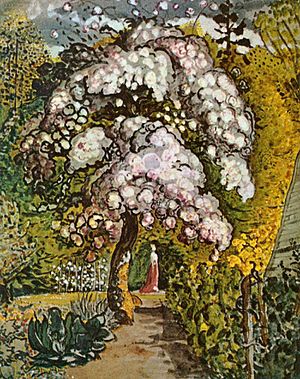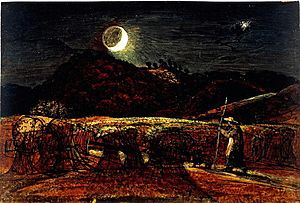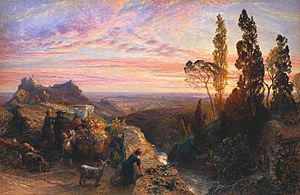Samuel Palmer facts for kids
Quick facts for kids
Samuel Palmer
|
|
|---|---|

Self portrait, c.1826
|
|
| Born |
Samuel Palmer
27 January 1805 London, England
|
| Died | 24 May 1881 (aged 76) Redhill, Surrey, England
|
| Known for | Painting, printmaking, drawing, |
|
Notable work
|
Garden in Shoreham, |
| Movement | The Ancients |
Samuel Palmer RWS Hon.RE (27 January 1805 – 24 May 1881) was a famous British artist. He painted beautiful landscapes, made etchings, and wrote a lot. He was an important part of the Romantic art movement in Britain. Palmer was known for his dream-like paintings of nature.
Contents
Early Life and Art Beginnings
Samuel Palmer was born in London, England. His father was a bookseller. Samuel started painting churches when he was about twelve years old. By age fourteen, he was showing his art at the Royal Academy, a famous art school. His early works were inspired by the artist Joseph Mallord William Turner. Samuel did not have much formal art training or schooling. He briefly attended Merchant Taylors' School, Northwood.
Life and Art in Shoreham
In 1824, Palmer met the famous artist William Blake through John Linnell. Blake's unique style greatly influenced Palmer's art for the next ten years. Many people believe this was Palmer's best period. He created landscapes around Shoreham, a village in Kent.
From 1826 to 1835, Palmer lived in a small, old cottage in Shoreham. He called it "Rat Abbey." He painted the area as a magical, dream-like place. His paintings often used dark, earthy colors and showed scenes under the moon and stars. In Shoreham, Palmer joined a group of artists called the Ancients. They were also inspired by William Blake. This group included George Richmond and Edward Calvert.
Palmer's father later moved to Shoreham, living in a house called the 'Waterhouse'. Palmer himself moved to the Waterhouse in 1828 and stayed there for the rest of his time in Shoreham. While living there, he fell in love with Hannah Linnell, who was the daughter of his friend John Linnell. Hannah was fourteen at the time. They later married.
Later Art and Life Changes
Palmer moved back to London in 1835. He used some money he inherited to buy a house. After returning to London, his art became less mystical and more traditional. He needed to sell his work and teach art to earn money. He also married Hannah Linnell when she was nineteen and he was thirty-two.
Palmer started using watercolour more often, as it was becoming popular in England. To help his career, he and Hannah went on a two-year trip to Italy in 1837. This trip was paid for by Hannah's parents. In Italy, Palmer used brighter colors in his paintings. He made many sketches that he would use later for new artworks.
When he returned to London, Palmer struggled to find people to buy his art. For over twenty years, he had to work as a private drawing teacher. This took up a lot of his time, leaving less for his own art.
Final Years and Important Works
From the early 1860s, Palmer started to get more recognition for his later landscapes. These works sometimes reminded people of his early Shoreham art. A notable example is his etching called The Lonely Tower (1879). He became a full member of the Water Colour Society in 1854. This gave him a goal each year to create new art for their annual show.
Some of his best later works include a series of large watercolours. These illustrated poems by John Milton, such as L'Allegro and Il Penseroso. He also created etchings, a type of printmaking, from 1850 onwards. These included a set illustrating the works of Virgil.
Palmer's later years were sad because his elder son, Thomas More Palmer, died in 1861 at age 19. This was a very difficult loss for him. He lived in several places, including Kensington and Reigate. In 1862, he gained some financial stability and moved to Furze Hill House in Redhill, Surrey.
Samuel Palmer died in Redhill, Surrey, in 1881. He is buried with his wife in St Mary's churchyard in Reigate.
Palmer's Legacy and Popularity
After his death, Samuel Palmer was largely forgotten for a while. In 1909, his son Alfred Herbert Palmer destroyed many of his Shoreham artworks. He burned sketchbooks, notebooks, and original pieces, believing no one would understand them.
However, interest in Palmer's work began to grow again in 1926. An exhibition at the Victoria & Albert Museum helped bring his art back into public view. Later, important books and another exhibition in the 1950s made his work much more popular. For example, a Shoreham drawing that sold for about £50 in the 1930s sold for £14,000 in 1969. In 2003, one of his watercolours sold for over £587,000!
Palmer's Shoreham work influenced many English artists. These included F. L. Griggs, Robin Tanner, Graham Sutherland, and John Minton. He also inspired a new interest in landscape printmaking in the 20th century.
Recent Exhibitions of Palmer's Art
In 2005, for the 200th anniversary of his birth, a major exhibition of Palmer's art was held. It showed 170 of his watercolours, drawings, etchings, and oil paintings. The exhibition, called Samuel Palmer: Vision and Landscape, was shown in London and New York. It focused on his early work but also included later, more realistic watercolours from his travels.
In 2012, another exhibition in London, Samuel Palmer, His Friends and Followers, displayed Palmer's influential landscapes. It also featured works by other artists he influenced, like Edward Calvert and George Richmond.
Honoring Samuel Palmer
There are several plaques that remember Samuel Palmer. One is at his birthplace in Surrey Square. The 'Waterhouse' in Shoreham, Kent, has a plaque marking his time living there. Another plaque is in Kensington, London, where he lived from 1851 to 1861. His last home in Redhill, called The Chantry, is also recognized for its connection to Palmer.
The oldest house in Shoreham, Kent, is now known as the Samuel Palmer School of Fine Art. The National Portrait Gallery has a portrait of Palmer from 1829, painted by his friend George Richmond. In Redhill, a street built in the 1960s is named Palmer Close in his honor.
Writings by Samuel Palmer
- An address to the Electors of West Kent: A pamphlet from 1832.
- The 1861 Lives Balance Sheet: An epitaph written after his son Thomas More Palmer died.
- On going to Shoreham, Kent to design from Ruth: A prayer from 1826.
- With pipe and rural chaunt along: A poem from Samuel Palmer's Sketchbook, 1824.
See also
 In Spanish: Samuel Palmer para niños
In Spanish: Samuel Palmer para niños
|




